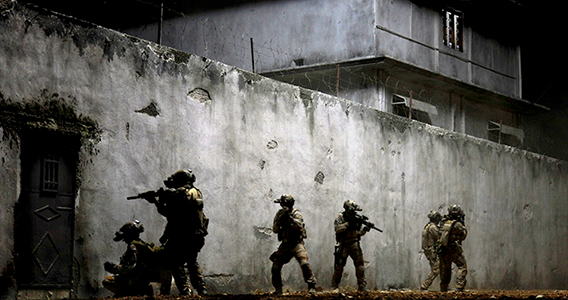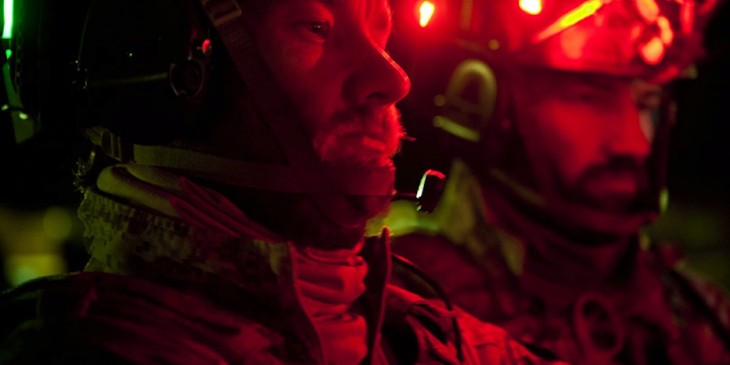Codex recorders and digital labs support Codex/ARRIRAW workflow
London, UK – 24 January 2013 – Codex digital cinema technology continues to prove its metal under the most challenging production conditions. Its latest test came on Zero Dark Thirty, Kathryn Bigelow’s gripping telling of the hunt for Osama bin Laden. Codex recorders and digital labs were employed to capture, manage and process camera data for a production that traveled to remote locations, accumulated huge amounts of original camera media, and shot some scenes in near-total darkness.
Zero Dark Thirty relates the complicated and far-ranging events of the 10-year effort to track down the al-Qaeda leader with extreme attention to historical accuracy. That is especially evident in the film’s final act, which focuses on the 2011 nighttime raid by Navy Seals on bin Laden’s compound in Pakistan. In order to mirror the real events as closely as possible, those scenes were shot at night with infrared lighting used to simulate the view of the Seals who were wearing night vision goggles.
It was because of such nighttime and low-light scenes that cinematographer Grieg Fraser elected to shoot the film with ARRI Alexa cameras and Codex Onboard M recorders. The Alexa’s sensor offered unsurpassed sensitivity to light and the Codex recorder’s ability to capture ARRIRAW data provided proven means for maintaining maximum image information. “The Codex recording solution was an obvious choice for me when shooting with Alexa,” notes Colin Wilson, an Executive Producer of the film, “the gear is solid and reliable and proven to work well in harsh environments. We shot all over the world under difficult conditions and Codex kept our data is safe.”

The Codex recorders’ relative light weight and compact size were also important to the production’s need for flexibility. Due to the remoteness and ruggedness of some of the locations, camera crews often worked with the Alexas in hand-held configurations. To make their job easier, workflow specialist Digilab Services provided camera assistants with backpacks to which the Codex recorders and other accessories were mounted.
“Digilab also designed lightweight injection-molded plastic shells to replace the original aluminum shells of the Codex Datapacks,” notes Codex Product Specialist James Eggleton. “Every effort was made to keep weight to an absolute minimum.”
Additionally, two Codex Digital Lab-3 systems were incorporated into a mobile digital laboratory infrastructure set up and maintained for the production by Digilab. The labs were used to copy picture data to two separate storage systems, assign names to clips according to conventions set by editorial, produce twice-verified LTO tape copies of data, perform visual QC, sync sound, apply a dailies grade, and render Avid DNxHD MXF media. An ACES color pipeline was used for the dailies grade.
“Most of the shoot was 4-camera, sometimes split into two units,” recalls Eggleton. “Whenever a splinter unit strayed far afield, one of the lab technicians followed with a Codex Lab and Storage-10 packs. That allowed the storage packs to be rotated between the two units, with tape archiving, QC and file deliverables handled at the main base.” The mobile lab was staffed by three Digilab technicians, working in shifts to minimize diskpack turnaround times.”
Each day ARRIRAW data from the Onboard Datapacks was collated to a Codex Storage-10 Diskpack (10TB RAID-3 protected) and to direct-attached SAS storage. Once the two copies were complete and verified, the datapacks were cleared and returned to set. “Datapacks were delivered to the lab in two splits, at lunch and at wrap,” Eggleton explains. “As a result, the morning's material was graded and ready to view by the DP and director on wrap.”
Zero Dark Thirty was the first production to use Codex's LTFS tape offloader module. Nearly 24 million ARRIRAW images were captured over the course of the shoot (approximately 276 hours), on a shooting average of 4-hours per day. The Codex Digital Labs were used to archive all of the ARRIRAW material to LTO-5 tape in LTFS format. “Typically, one Codex Digital Lab was dedicated to archiving the previous day's material while the other was used to organize and clone the data from the current shooting day,” Eggleton says. “During the busiest sections of the shoot, both labs were either cloning data or archiving to tape 24-hours a day.”
System logs from the Codex and Mac machines were sent on a daily basis to Digilab’s London office so that lab processes (archiving, data verification) could be cross-checked with the LTO tapes that were being shipped back to London. All digital assets were tracked throughout the shoot from the London base.

Did you enjoy this article? Sign up to receive the StudioDaily Fix eletter containing the latest stories, including news, videos, interviews, reviews and more.